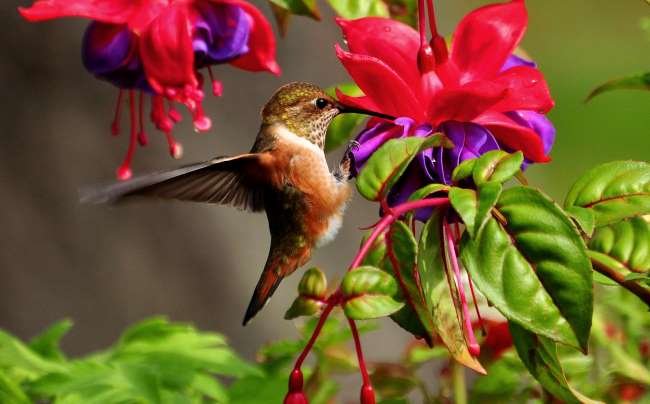
Facts About Humming Bird
Here you will come to know the amazing facts about Hummingbird.
''Interesting facts about hummingbirds always fascinates birds lover people".
Hummingbirds are fascinating little birds. They have the smallest body size mainly found in North America and the fastest wings and heartbeats.
They have the most efficient metabolisms and lay the smallest eggs. These are just a few of the amazing features that make hummingbirds a study in extremes.
This blog will look at how these tiny birds can teach us about extremes in life.
It's always exciting to hear the hummingbirds' distinctive voices as they approach the feeder... Like a bumblebee who has had too much coffee.
They dart back and forth, up and down, alternately eating and hovering in place to take a break from their meal.
You especially enjoy it when they sit on the feeder with their tiny feet and take a long, seemingly soothing drink of the delicious sugar and water mixture that they adore and which gives them nourishment.
What is a Hummingbird?
Hummingbirds are tiny, bright, thin-beaked birds that receive their name from the humming sound they make when they flap their wings quickly.
Hummingbirds are native to the New World (North and South America during the European "era of discovery" in the early 16th century).
1. Humming Bird has a Large Number of Species

masterimages
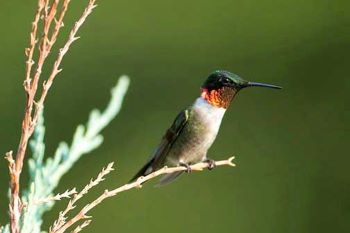
masterimages
There are over 330 species of hummingbirds, according to a National Geographic television show on the subject.
I was taken aback. I had no idea because I was only familiar with one species, the Ruby-Throated Hummingbird, as I'm sure you are.
Surprisingly, hummingbirds are exclusively found in the Western Hemisphere, with over half of the species found around the equator.
About 5% of hummingbird species inhabit predominantly north of Mexico, with only a few dozen species visiting the United States and Canada.
Along the Pacific coast, a few species can be found year-round in the United States.
2. They're the Smallest
Hummingbirds are the tiniest bird species.
The Cuban bee hummingbird weighs only 1.95 grams or roughly the same as a quarter teaspoon of sugar!
Hummingbirds have the smallest eggs of any bird, so it makes sense that they have the smallest eggs of any bird.
A Ruby-throated hummingbird's egg is approximately the size of a pea, and its nest is approximately the size of half a walnut shell.
And they want to live in gardens since they are isolated and quiet. So, before you start spring cleaning in your yard, please examine the branches.
3. What does a Hummingbird Eat ?

Courtesy : Jasmin Robinson
Hummingbirds are commonly seen at nectar blossoms and sugar-water feeders, but they can eat tree secretions and tiny insects when flowers are scarce in the wild.
Hummingbirds require high-octane nutrition such as nectar, but they also require protein to construct their bodies.
They devote a significant amount of time to finding and eating the small insects, spiders, and other arthropods that offer the essential chemical.
Hummingbirds catch insects in the air thanks to their incredible agility and a remarkable adaption that essentially turns their bills into spring-loaded pairs of chopsticks.
Hummingbirds use their long, thin, tiny beaks like straws, according to the casual observer.
Their tongues serve as a little pump, sucking the sweet liquid from feeders and flowers.
They collect earthbound meals from spiderwebs, foliage, and other locations while hovering. Because sweet gushing tree fluid has a high sugar content, similar to nectar, it's great for hummers—but they can't get to it without a little help.
Each bird has a thin tongue that forks at the tip and springs open to collect fluid; then, when the bill closes, the tongue retracts, compressing the tongue and allowing the bird to drink the nectar.
Sapsuckers create rows of sap wells by drilling holes into trees for food. Some hummingbird species enjoy the sap from these wells.
This is repeated 15 to 20 times each second by hummers.
4. They Eat a Great Amount of Food
Hummingbirds have a fast metabolism and must eat constantly to stay alive.
The daily dose is half of their body weight, They eat bugs and nectar, feeding every 10-15 minutes and visiting 1,000-2,000 blooms per day.
These hummingbirds eat small insects, ants, aphids, beetles, gnats, mosquitoes, and wasps in addition to nectar from flowers and feeders. Hummingbirds are wonderful to have on your lawn!
5. Hummingbirds fly incredible distances during their migration.

Photo by Bryan Hanson on Unsplash
The Calliope Hummingbird is the world's smallest long-distance migratory bird, traveling more than 5,000 kilometers per year.
The Rufous Hummingbird is also a long-distance flier, traveling 3,900 miles.
Hummingbird migration can be shockingly swift due to the birds' extraordinary flight ability: the Ruby-throated Hummingbird, for example, performs an uninterrupted 500-mile voyage across the Gulf of Mexico in less than a day.
Rufous hummingbirds migrate farther than any other North American species, according to one of the most fascinating hummingbird facts.
They migrate 4,000 miles from Mexico to Alaska every spring.
6. Hummingbirds were present in Europe 30 million years ago.
Hummingbirds are now only found in the Americas, but this was not always the case.
In 2004, the earliest hummingbird fossil was discovered in Germany.
Scientists are still puzzled as to why hummingbirds vanished from Europe.
7. Do Hummingbirds Always return to the Same place

Courtesy : Alicia Casey
You may be correct if you think the same hummingbirds return to your feeders and bloom year after year.
They are most likely to return to the location where they hatched, according to banding data.
When is the best time to hang hummingbird feeders in the spring?
8. Female Builders Hummingbirds

Courtesy : USFW
Female hummingbirds are the only ones who build nests, and they only lay two eggs.
The male hummingbird does not participate in the rearing of young and will frequently find another mate after the young have hatched.
Baby hummingbirds will stay in the nest for around three weeks after hatching.
9. Hummingbirds go on Vacation.
One aspect of hummingbirds that surprised me was their ability to migrate.
In fact, some hummingbirds travel more than 2,000 miles twice a year.
They spend the winter in Central America or Mexico before migrating north to their breeding grounds in the United States in late winter and early spring.
Hummingbirds will typically gain 25-40% of their body weight before beginning their migration in order to complete their journey.
They usually fly alone, often on the same route, they took earlier in their lives.
Hummingbirds fly during the day when nectar sources are plentiful. They also fly low, allowing the birds to see and stop for food along the way.
According to research, a hummingbird can fly up to 23 miles in a single day.
10. They Know How to Move
Hummingbirds have a unique style of flying that can fly like them.
They have the ability to fly backward, forward, and even upside down!
Hummingbirds are also the only vertebrae capable of hovering during flight for an extended period of time.
11. Hummingbirds are the only birds in the world that migrate alone.
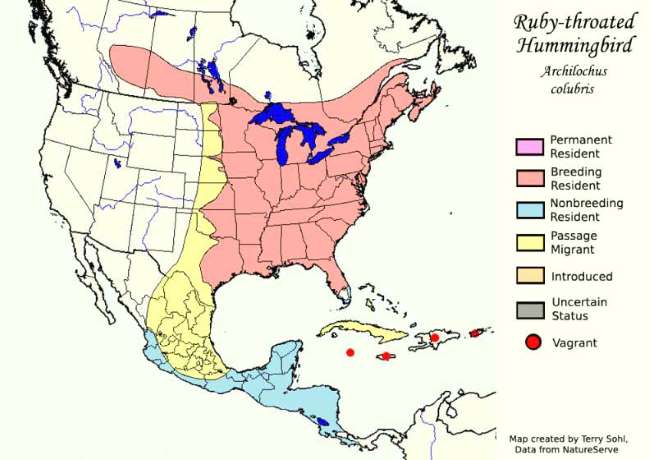
Source : https://sdakotabirds.com
A tranquil Allen's hummingbird perches on a branch, according to Robers Hoan Allen's hummingbird sits peacefully on a limb.
You won't see hummingbirds moving in groups because they are solitary travelers.
Species-specific wintering sites exist. During the winter, most ruby-throats spend their time between southern Mexico and northern Panama.
This is why hummingbird feeders should be kept up for late-migrating hummingbirds.
12. They're also Fast.
Hummingbirds have speed and stamina in addition to being agile.
In direct flight, they can reach speeds of over 30 mph, and during courting dives, they can reach speeds of more than 45 mph.
Hummingbirds not only fly from one location to another quickly, but their body components do as well.
When a hummingbird is at rest, its heart beats around 225 times per minute, but when it is flying, it beats at almost 1,200 times per minute.
In normal flying, its wings beat at roughly 70 times per second, but when diving, they pump at moreover 200 times per second.
13. What Color Do Hummingbirds Have?
The color and arrangement of iridescent elements on hummers vary greatly.
Even among the few hummingbird species found in the United States, the variety of colors is amazing.
The throats of male Allen's and rufous hummers are a brilliant red-orange color.
Anna's hummer is a stunning male with a dazzling magenta throat, face, and crown.
The Costa's hummingbird, whose neck feathers curve into long mustache-like points on each side, has a royal purple head wrap.
14. Hummingbirds also take a Break.
Hummingbirds are one of the few bird species that can enter hibernation.
It is a deep, sleep-like state in which metabolic functions are slowed to a halt and an extremely low body temperature is maintained.
Hummingbirds have high metabolic demands and their feathers are poor insulators, thus falling into torpor allows them to live when conditions make maintaining their regular 105°F body temperature impossible.
15. What are the brightly colored patches on their necks?
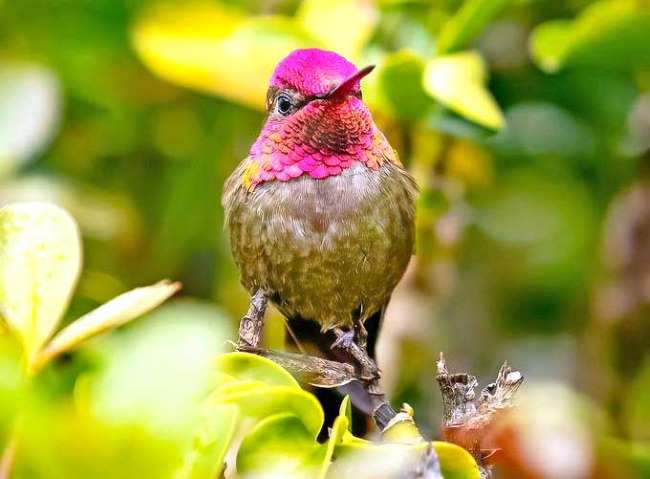
Courtesy : Monica Slacks
A hummingbird's colorful radiance explodes with the turn of its head.
Depending on the species, its gorget (the patch of colorful feathers covering its throat) instantly blazes in shades that span the color spectrum.
The brilliant colors are caused by the feather structure rather than pigmentation.
Each iridescent feather is densely packed with tiny spikes and many layers of microscopic structures filled with air bubbles.
According to Bob Sundstrom, a science advisor for BirdNote, these structures reflect light, "creating color in the manner of sun glinting off an oily film on water."
Hummingbirds can go into torpor at any time of year, depending on temperature and food availability.
(We'd name it hibernation if torpor lasted for a long time.)
16. Hummingbirds are aggressive
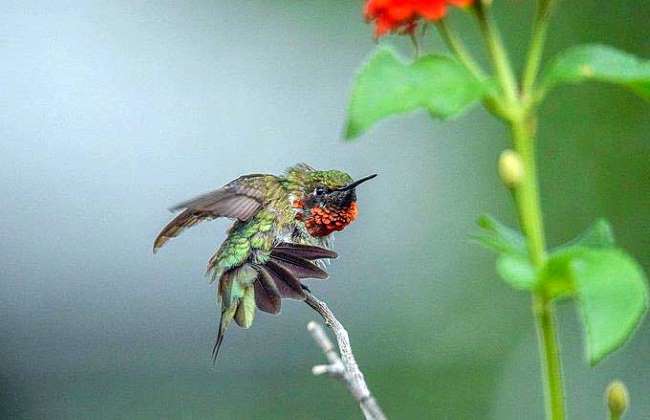
Courtesy : Ande Findlay
A male ruby-throated hummingbird defends his feeding zone with vigor. Hummingbirds, despite their small size, maybe very territorial.
They devote a lot of their time to chasing other birds away from the feeders or flowers they're guarding.
"Nectar-drinking birds are more aggressive," Chris explains.
The best hypothesis proposed by the researchers is as follows: Most birds have to hunt for their food, which can be hidden seeds or grubs, whereas hummingbirds feed on flowers that are naturally spectacular.
That means they can see all of their food sources, but the rivals can, too.
"They developed to be really violent in order to guard that food against other creatures who could try to eat it," Chris explains.
17. How Do Hummingbirds Select Flowers?
Another amazing hummingbird fact is that they have excellent eyesight.
They can see color even better than we can, with a vision that extends into the ultraviolet spectrum.
Their eyes have evolved to see warmer tones more clearly than cooler tones.
Because they can easily distinguish orange, yellow, and red blooms within a sea of chilly green, it has long been assumed that they prefer red above other colors.
Since then, scientists have discovered that the richness of the nectar is more important than the color of its source.
The birds are quick to learn, and they are looking for food. You may attract them to your yard as well with the correct flowers and feeders.
18. They're anti-social (and can be obnoxious!)
Hummingbirds, on the whole, are solitary creatures. When there are multiple hummingbirds around, they often engage in a series of high-speed chases seeking food sources.
Mating season can be competitive, and male hummingbirds can be aggressive.
Male hummingbirds will swing and swirl to demonstrate their power, then use their needle-like beaks as knives to stab each other in the throat. To get its mate, the male used a violent method.
19. Hummingbird nests are really small.
Even if you're well-versed in hummingbird facts, discovering one of their nests is a particular treat.
A half-dollar coin is about the size of the average nest. Inside the tiny framework, the eggs resemble microscopic white jelly beans.
Everything you need to know about hummingbird nests is right here.
20. Big-Brained Bird
The weight of the humming brain accounts for 4.2% of its total weight.
It makes the hummingbird the largest proportion of brain among any bird. In comparison, our brains account for only 2% of our total body weight.
Hummingbirds have been found to recall migration paths and every flower they've ever visited in research shows.
They may also determine how long they should wait between trips to allow the flowers to produce more nectar.
They recognize human beings very well
21. Hummingbirds use spiderwebs to build their nests.
A hummingbird's nest takes less than a week to build (approximately five to seven days).
Nests are made of lichen, moss, and spiderwebs and are exclusively built by females.
Take a look at these 10 lovely baby hummingbird photos.
22. Hummingbirds Breathe Quickly
The average 4-inch hummingbird takes roughly 150 breaths per minute while resting.
Learn the truth about typical hummingbird misconceptions.
23. Hummingbirds have the ability to hover and fly backward.
These hummingbird facts will astound your friends. No other bird can match the hummingbird's wing agility.
They are the only birds that can fly backward and hover in midair at flowers and feeders.
Their wings move in a figure-eight pattern, allowing them to maneuver easily. With each downstroke of their wings, other birds generate the lift required for flight.
To put it another way, typical bird flight is accomplished by flipping the wings up and down.
The structure of a hummingbird's wing joints, not the speed of its wings, allows it to hover.
24. How Fast Do Hummingbirds Fly?
Hummingbirds may flip their wings by rotating or twisting the upper arm bones.
This propels them into the air on both the up and down strokes. As a result, They are the world's most acrobatic birds.
The calliope hummingbird is considered the smallest bird in the USA. What is the top speed of a hummingbird?
The hum of a hummingbird is caused by air passing around its wings.
Hummingbirds, known for their unpredictable and agile motions, beat their wings more than 50 times per second, and even quicker in extreme flying mode.
They're also among the quickest fliers for their size, with courtship dives reaching speeds of up to 37 mph and up to 60 mph.
25. Singing Hummingbirds
Though not as vociferous as songbirds, several hummingbird species, particularly male Anna's and Costa's, are regular singers.
Other species' most common sounds are hostile calls that sound like chattering or screeching.
You'll see them when a group of hummingbirds congregates near a food source. Learn more about the many noises made by hummingbirds.
26. Whirring Tail Feathers
Chris Clark, an associate professor at the University of California, Riverside, began researching Anna's hummingbirds and became curious about their tails.
"They're these tiny fighter jets," he explains."How come they're developing such long tails that could slow them down?"
27. Hummingbirds are attracted to birdbaths.

Courtesy : Desiree Skatvold
This hummingbird couldn't resist a bubbling fountain.
Hummingbirds are attracted to a birdbath with a small mister, bubbler, or sprayer.
They may also fly through the mist of lawn sprinklers, which is a unique sight! The feathers of hummingbirds are precisely groomed.
They are similar to race car drivers in that they take great care to ensure that all parts of their vehicles are in perfect functioning order.
Hummers enjoy taking a shower—or even a bath—to keep their plumage clean, and they are drawn to landscapes with water elements, whether intended or not.
Hummers, of course, frequent birdbaths and other standing-water facilities.
28. Hummingbirds have Olympic-style metabolisms.

Courtesy : Brent Barnes
Because they must feed every 10 to 15 minutes, hummingbirds actively guard their food sources.
Hummers expend a lot of energy while they fly. They absorb levels of sugar that would be harmful to other animals as a result of this mechanism.
Ken Welch Jr., an associate professor at the University of Toronto Scarborough, was inspired to research hummingbird metabolism because of this.
"Even when they're fasting, hummingbirds maintain a blood sugar level that would make your primary care physician squirm," Ken says.
The digestive organs of hummingbirds are extremely efficient. According to Ken, the sugar soon enters their circulation.
"An exceptional human endurance athlete can attain roughly ten times what an average hovering metabolic rate of Anna's hummingbird can reach, gramme per gramme," Ken explains.
When birds go into torpor to preserve energy or bulk up before migration, their high-speed metabolism slows dramatically.
"They may go from having the quickest metabolic rate of any bird while hovering to having the lowest metabolic rate of any bird while in torpor," Ken says.
A study of hummingbird facts and biological extremes, to be sure.
29. Innovative Hummingbird Photography
National Geographic published a sequence of images by Harold Edgerton of a ruby-throated hummingbird frozen in flight in August 1947.
The photographs document a seminal invention that has influenced our understanding of hummingbirds to this day: the advent of the electric flash, which could create a burst of light lasting 1/100,000 of a second.
This allowed us to capture images that our eyes couldn't perceive, such as the wings of a hovering hummingbird.
This enabled bird watchers to study hummingbird statistics and enjoy these small dynamos in hitherto unseen detail.
The Very First Hummingbird Feeders
Another important invention was the feeder that drew the ruby-throated hummingbird's attention.
Laurence Webster designed the blown-glass sugar water feeder to feed hummingbirds in his New England gardens.
Readers of National Geographic were captivated by the idea of feeding hummingbirds and soon desired their own feeders.
Audubon Novelty Company introduced the first commercially marketed hummingbird feeder, dubbed "the Webster Hanging Feeder," in 1950.